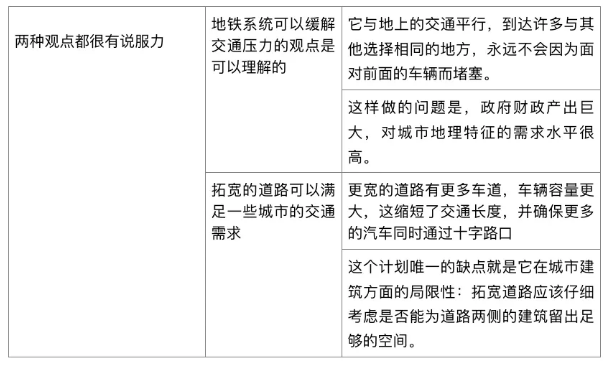Some people argue that building the underground railway system can ease the pressure on the transport system, while others think building or broadening roads can achieve this. Discuss both views and give your own opinion.
题目大意
一些人认为修建地下铁路系统可以缓解交通系统的压力,而另一些人则认为修建或拓宽道路可以实现这一点。讨论这两种观点,并给出你自己的意见。
写作思路解析
➡️我认为这两种观点都很有说服力,并不相互矛盾;能否通过地下系统或道路拓宽来缓解交通压力,在一定程度上取决于不同的城市特色。
➡️地铁系统可以缓解交通压力的观点是可以理解的,持这种观点的人可能会关注这个系统可以给许多城市带来什么,也已经给许多城市带来了什么。这种类型的公共交通模式当然是有效的,因为它从来不受任何其他交通工具的限制。它与地上的交通平行,到达许多与其他选择相同的地方,永远不会因为面对前面的车辆而堵塞。这一系统在大多数城市相对实惠的票价,也让很大一部分通勤者和其他乘客将其作为出行的首选。所有这些优势都缓解了道路上的拥堵情况。然而,这样做的问题是,政府财政产出巨大,对城市地理特征的需求水平很高。决定建设这个系统的城市应该首先确保提前有足够的预算,并且地下的状况是安全的,足以进行进一步的建设。
➡️另一方面,上面列出的问题也可能在一定程度上解释了为什么其他人认为拓宽的道路可以满足一些城市的交通需求。更宽的道路有更多车道,车辆容量更大,这缩短了交通长度,并确保更多的汽车同时通过十字路口。此外,拓宽道路的政策也是一种比建立地下交通系统更便宜的方式,因为施工门槛较低,不需要花费太多钱购买设施和专业知识。这样做安全也不成问题,只是在既有道路系统的基础上推出的一个项目。这个计划唯一的缺点就是它在城市建筑方面的局限性:拓宽道路应该仔细考虑是否能为道路两侧的建筑留出足够的空间。对于一些城市,特别是那些历史上著名的城市,这样的行动也应该避免破坏它们道路的文化价值。
总而言之,这两种改善城市交通的方法在大多数情况下都是适用的,但城市应该仔细权衡成本效益比和城市地理现实等因素,以做出合适的决策。
提纲梳理见下
写作示范
I would argue in this essay that both the views given by the topic are persuasive and not contradict one another at all; whether or not traffic pressures can ease through the underground system or road broadening depends to some extent on different urban features.
The opinion that a subway system can release the traffic pressure is understandable; people holding this may focus on what this system could and has already brought to many cities. This type of public traffic model is certainly efficient since it is never limited by any other transports. It is parallel to the traffic aboveground, reaching many of the same places as other options do and never gets stuck by facing vehicles ahead. The relatively affordable ticket price of this system in most cities also allows a large portion of commuters and other passengers to take it as the first choice for travel. All these edges ease the congesting scenario on the road. The problems of this, however, are the large governmental financial output and the high level of demand for the geographic feature of a city. Cities deciding to build this system should first ensure there would be enough budget in advance, and the condition underground is safe and available enough for further construction.
The problems listed above, on the other hand, may also contribute partly to why others hold that a broadened road can fulfill the traffic demands of some cities. Broader roads have greater capacities of vehicles with more lanes; this shortens the traffic length and ensures more cars get through the crossroads at one time. Moreover, the policy of broadening roads is also a cheaper way than establishing an underground traffic system since there are lower constructing barriers and no need to spend too much money purchasing facilities and expertise. The safety is also out of a problem when doing this——it is only a program launched based on the established road system. The only disadvantage of this plan is its limitation in terms of the architectures of a city: the road broadening should meticulously think whether it can leave enough space for the buildings erected on both sides of the road. For some cities, notably those historically famous ones, such action should also avoid destroying the cultural values of their roads.
In conclusion, either the two means of bettering the urban traffic is adaptable in most cases, but cities should carefully balance factors like the cost-benefit rates and the urban geographic reality to make the most suitable decision.


